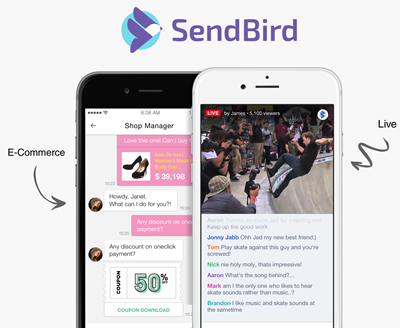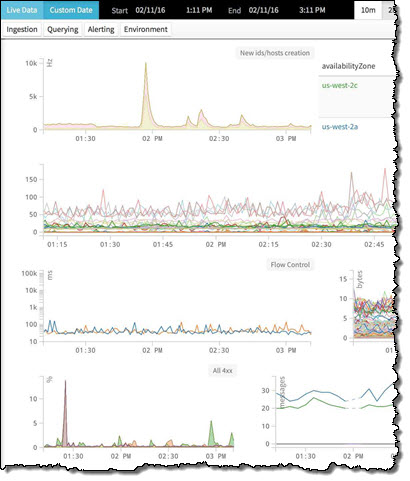AWS News Blog
AWS Hot Startups – August 2016
|
|
Back with her second guest post, Tina Barr talks about four more hot startups!
— Jeff;
This month we are featuring four hot AWS-powered startups:
- Craftsvilla – Offering a platform to purchase ethnic goods.
- SendBird – Helping developers build 1-on-1 messaging and group chat quickly.
- Teletext.io – A solution for content management, without the system.
- Wavefront – A cloud-based analytics platform.
Craftsvilla
 Craftsvilla was born in 2011 out of sheer love and appreciation for the crafts, arts, and culture of India. On a road trip through the Gujarat region of western India, Monica and Manoj Gupta were mesmerized by the beautiful creations crafted by local artisans. However, they were equally dismayed that these artisans were struggling to make ends meet. Monica and Manoj set out to create a platform where these highly skilled workers could connect directly with their consumers and reach a much broader audience. The demand for authentic ethnic products is huge across the globe, but consumers are often unable to find the right place to buy them. Craftsvilla helps to solve this issue.
Craftsvilla was born in 2011 out of sheer love and appreciation for the crafts, arts, and culture of India. On a road trip through the Gujarat region of western India, Monica and Manoj Gupta were mesmerized by the beautiful creations crafted by local artisans. However, they were equally dismayed that these artisans were struggling to make ends meet. Monica and Manoj set out to create a platform where these highly skilled workers could connect directly with their consumers and reach a much broader audience. The demand for authentic ethnic products is huge across the globe, but consumers are often unable to find the right place to buy them. Craftsvilla helps to solve this issue.
The culture of India is so rich and diverse, that no one had attempted to capture it on a single platform. Using technological innovations, Craftsvilla combines apparel, accessories, health and beauty products, food items and home décor all in one easily accessible space. For instance, they not only offer a variety of clothing (Salwar suits, sarees, lehengas, and casual wear) but each of those categories are further broken down into subcategories. Consumers can find anything that fits their needs – they can filter products by fabric, style, occasion, and even by the type of work (embroidered, beads, crystal work, handcrafted, etc.). If you are interested in trying new cuisine, Craftsvilla can help. They offer hundreds of interesting products from masalas to traditional sweets to delicious tea blends. They even give you the option to filter through India’s many diverse regions to discover new foods.
Becoming a seller on Craftsvilla is simple. Shop owners just need to create a free account and they’re able to start selling their unique products and services. Craftsvilla’s ultimate vision is to become the ‘one-stop destination’ for all things ethnic. They look to be well on their way!
AWS itself is an engineer on Craftsvilla’s team. Customer experience is highly important to the people behind the company, and an integral aspect of their business is to attain scalability with efficiency. They automate their infrastructure at a large scale, which wouldn’t be possible at the current pace without AWS. Currently, they utilize over 20 AWS services – Amazon Elastic Compute Cloud (Amazon EC2), Elastic Load Balancing, Amazon Kinesis, AWS Lambda, Amazon Relational Database Service (RDS), Amazon Redshift, and Amazon Virtual Private Cloud (Amazon VPC) to name a few. Their app QA process will move to AWS Device Farm, completely automated in the cloud, on 250+ services thanks to Lambda. Craftsvilla relies completely on AWS for all of their infrastructure needs, from web serving to analytics.
Check out Craftsvilla’s blog for more information!
SendBird
 After successfully exiting their first startup, SendBird founders John S. Kim, Brandon Jeon, Harry Kim, and Forest Lee saw a great market opportunity for a consumer app developer. Today, over 2,000 global companies such as eBay, Nexon, Beat, Malang Studio, and SK Telecom are using SendBird to implement chat and messaging capabilities on their mobiles apps and websites. A few ways companies are using SendBird:
After successfully exiting their first startup, SendBird founders John S. Kim, Brandon Jeon, Harry Kim, and Forest Lee saw a great market opportunity for a consumer app developer. Today, over 2,000 global companies such as eBay, Nexon, Beat, Malang Studio, and SK Telecom are using SendBird to implement chat and messaging capabilities on their mobiles apps and websites. A few ways companies are using SendBird:
- 1-on-1 messaging for private messaging and conversational commerce.
- Group chat for friends and interest groups.
- Massive scale chat rooms for live-video streams and game communities.
As they watched messaging become a global phenomenon, the SendBird founders realized that it no longer made sense for app developers to build their entire tech stack from scratch. Research from the Localytics Data Team actually shows that in-app messaging can increase app launches by 27% and engagement by 3 times. By simply downloading the SendBird SDK (available for iOS, Android, Unity, .NET Xamarin, and JavaScript), app and web developers can implement real-time messaging features in just minutes. SendBird also provides a full chat history and allows users to send chat messages in addition to complete file and data transfers. Moreover, developers can integrate innovative features such as smart-throttling to control the speed of messages being displayed to the mobile devices during live broadcasting.
After graduating from accelerator Y Combinator W16 Batch, the company grew from 1,000,000 monthly chat users to 5,000,000 monthly chat users within months while handling millions of new messages daily across live-video streaming, games, ecommerce, and consumer apps. Customers found value in having a cross-platform, full-featured, and whole-stack approach to a real-time chat API and SDK which can be deployed in a short period of time.
SendBird chose AWS to build a robust and scalable infrastructure to handle a massive concurrent user base scattered across the globe. It uses EC2 with Elastic Load Balancing and Auto Scaling, Route 53, S3, ElastiCache, Amazon Aurora, CloudFront, CloudWatch, and SNS. The company expects to continue partnering with AWS to scale efficiently and reliably.
Check out SendBird and their blog to follow their journey!
Teletext.io
 Marcel Panse and Sander Nagtegaal, co-founders of Teletext.io, had worked together at several startups and experienced the same problem at each one: within the scope of custom software development, content management is a big pain. Even the smallest correction, such as a typo, typically requires a developer, which can become very expensive over time. Unable to find a proper solution that was readily available, Marcel and Sander decided to create their own service to finally solve the issue. Leveraging only the API Gateway, Lambda functions, Amazon DynamoDB, S3, and CloudFront, they built a drop-in content management service (CMS). Their serverless approach for a CMS alternative quickly attracted other companies, and despite intending to use it only for their own needs, the pair decided to professionally market their idea and Teletext.io was born.
Marcel Panse and Sander Nagtegaal, co-founders of Teletext.io, had worked together at several startups and experienced the same problem at each one: within the scope of custom software development, content management is a big pain. Even the smallest correction, such as a typo, typically requires a developer, which can become very expensive over time. Unable to find a proper solution that was readily available, Marcel and Sander decided to create their own service to finally solve the issue. Leveraging only the API Gateway, Lambda functions, Amazon DynamoDB, S3, and CloudFront, they built a drop-in content management service (CMS). Their serverless approach for a CMS alternative quickly attracted other companies, and despite intending to use it only for their own needs, the pair decided to professionally market their idea and Teletext.io was born.
Today, Teletext.io is called a solution for content management, without the system. Content distributors are able to edit text and images through a WYSIWYG editor without the help of a programmer and directly from their own website or user interface. There are just three easy steps to get started:
- Include Teletext.io script.
- Add data attributes.
- Login and start typing.
That’s it! There is no system that needs to be installed or maintained by developers – Teletext.io works directly out of the box. In addition to recurring content updates, the data attribution technique can also be used for localization purposes. Making a website multilingual through a CMS can take days or weeks, but Teletext.io can accomplish this task in mere minutes. The time-saving factor is the main benefit for developers and editors alike.
Teletext.io uses AWS in a variety of ways. Since the company is responsible for the website content of others, they must have an extremely fast and reliable system that keeps website visitors from noticing external content being loaded. In addition, this critical infrastructure service should never go down. Both of these requirements call for a robust architecture with as few moving parts as possible. For these reasons, Teletext.io runs a serverless architecture that really makes it stand out. For loading draft content, storing edits and images, and publishing the result, the Amazon API Gateway gets called, triggering AWS Lambda functions. The Lambda functions store their data in Amazon DynamoDB.
Read more about Teletext.io’s unique serverless approach in their blog post.
Wavefront
 Founded in 2013 and based in Palo Alto, Wavefront is a cloud-based analytics platform that stores time series data at millions of points per second. They are able to detect any divergence from “normal” in hybrid and cloud infrastructures before anomalies ever happen. This is a critical service that companies like Lyft, Okta, Yammer, and Box are using to keep running smoothly. From data scientists to product managers, from startups to Fortune 500 companies, Wavefront offers a powerful query engine and a language designed for everyone.
Founded in 2013 and based in Palo Alto, Wavefront is a cloud-based analytics platform that stores time series data at millions of points per second. They are able to detect any divergence from “normal” in hybrid and cloud infrastructures before anomalies ever happen. This is a critical service that companies like Lyft, Okta, Yammer, and Box are using to keep running smoothly. From data scientists to product managers, from startups to Fortune 500 companies, Wavefront offers a powerful query engine and a language designed for everyone.
With a pay-as-you-go model, Wavefront gives customers the flexibility to start with the necessary application size and scale up/down as needed. They also include enterprise-class support as part of their pricing at no extra cost. Take a look at their product demos to learn more about how Wavefront is helping their customers.
The Wavefront Application is hosted entirely on AWS, and runs its single-tenant instances and multi-tenant instances in the virtual private cloud (VPC) clusters within AWS. The application has deep, native integrations with CloudWatch and CloudTrail, which benefits many of its larger customers also using AWS. Wavefront uses AWS to create a “software problem”, to operate, automate and monitor clouds using its own application. Most importantly, AWS allows Wavefront to focus on its core business – to build the best enterprise cloud monitoring system in the world.
To learn more about Wavefront, check out their blog post, How Does Wavefront Work!
